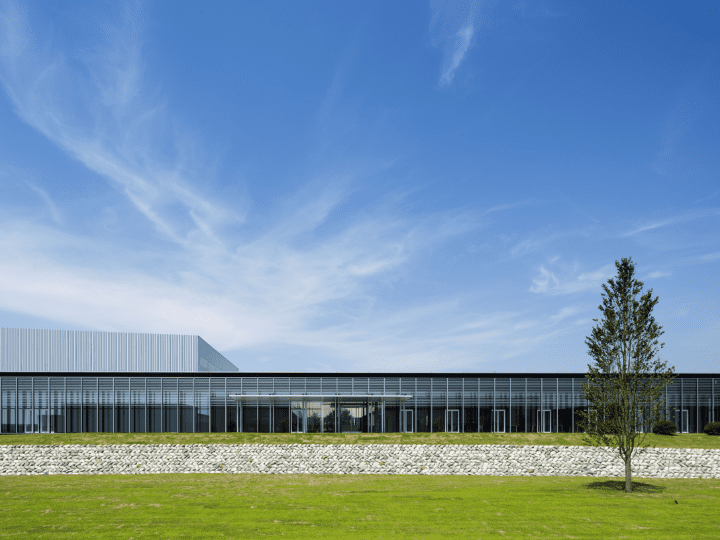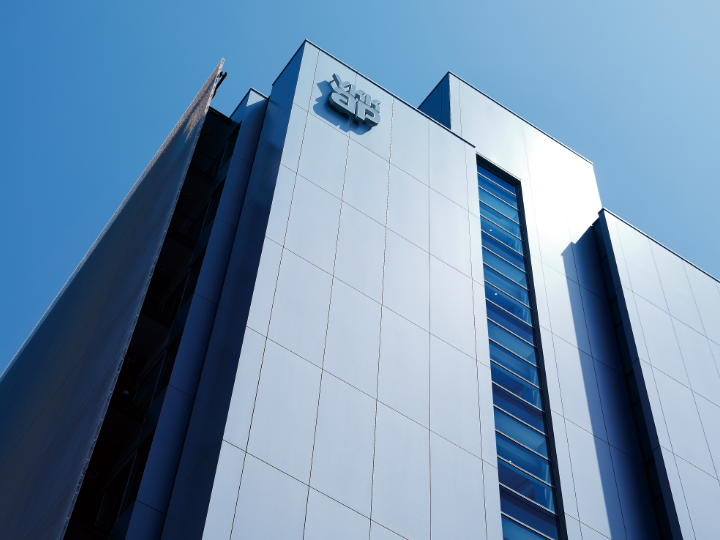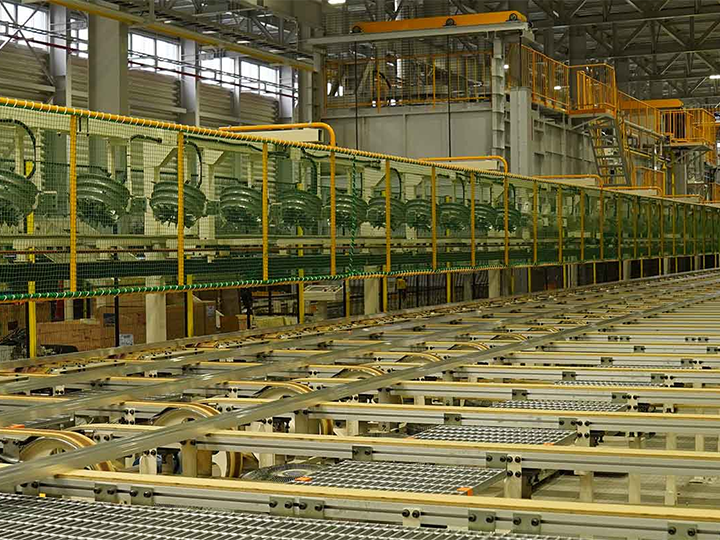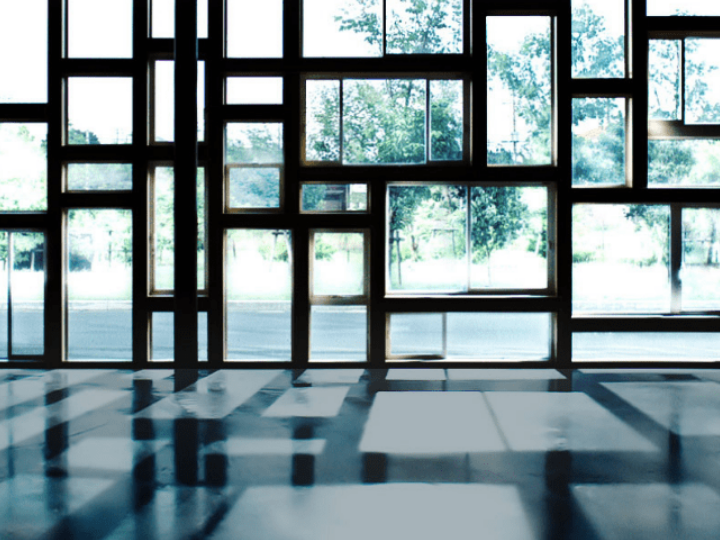
Toward sustainable logistics with Tokyo Metropolitan Area DC, a logistics site that aims to solve the 2024 problem
"We Build a Better Society Through Architectural Products." This is YKK AP's Purpose and the meaning of our existence as we conduct our business of developing, manufacturing, and selling windows, doors, interior architectural products, exterior products, curtain walls, and other items. Logistics is the discipline responsible for ensuring supply. This article covers our efforts to reduce driver working hours at our logistics site Tokyo Metropolitan Area DC through the changes we are making to our inventory management and transportation methods, as well as our implementation of efficient sorting through the introduction of shelf-transporting robots.
What is the “2024 problem” in logistics?
As part of work style reforms in the logistics industry, a cap will be imposed on overtime hours for truck drivers from April 2024. Although this is expected to improve working conditions for drivers, there are concerns that it will cause a shortfall in transportation capacity, preventing the transportation of goods and materials. The so-called "2024 problem in logistics" will have a significant impact on our own logistics, so, as a shipper, we have been working to improve the efficiency and productivity of our logistics. In 2016, we began development on pallets to improve transportation efficiency and introduced a system to optimize the loading of goods onto trucks. We have also been promoting "unit-loading," a method of efficiently transporting goods in pallet units. Now that the unit-loading transportation system has been established, we are striving to make our logistics even more sustainable.
(For more on our efforts promoting unit-loading, see: https://www.ykkapglobal.com/en/stories/20230411)

Establishing a logistics site to reinforce the supply system in the Tokyo metropolitan area
We spoke to Mitsuhiro Migitani, manager of the Logistics Section in the Manufacturing Division at YKK AP's Saitama MADO (Window) Plant, about the initiatives being undertaken at the Tokyo Metropolitan Area DC, a logistics site that will become operational in October 2023.
YKK AP's monozukuri integrates all manufacturing processes within the company's own production sites, from the development and manufacture of materials and components to their processing and assembly. In order to ensure a stable supply of high-quality products, our in-house logistics divisions manage the transportation routes between logistics sites and the delivery networks connecting the logistics sites to product destinations. Our logistics sites are divided into two categories: Distribution Centers (DC), where products are stored and kept in inventory until they are shipped, and Transfer Centers (TC), where products are sorted and shipped, but not stored. DCs are located close to production sites, while TCs function as relay points, and are therefore located close to the delivery areas. Until now, supply to the metropolitan area of Tokyo and its surrounding seven prefectures has been handled by the Tokyo Metropolitan Area TC, but with the addition of inventory storage, its functions have been expanded, turning it into a DC. Dubbed the "Tokyo Metropolitan Area DC," this distribution center will strengthen the supply system of windows, doors and exterior products for residential homes to the Tokyo metropolitan area.

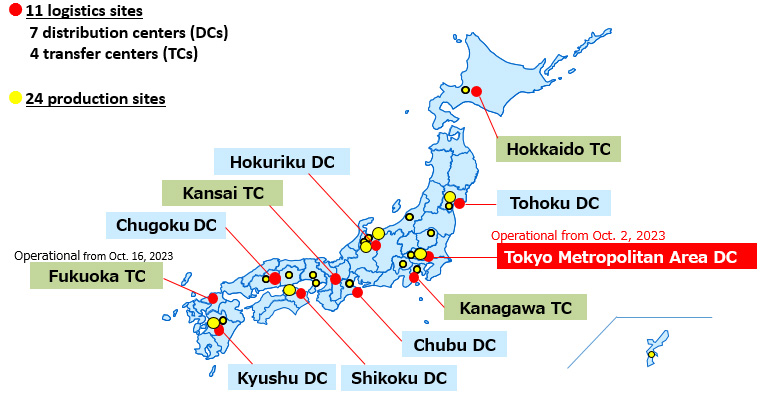
YKK AP's logistics sites (as of September 2023)
Achieving higher inventory turnover and a pleasant working environment for drivers and on-site workers
We carry a broad range of products, from windows to doors for both homes and commercial buildings. We also offer "immediate delivery" for urgent items, as well as "scheduled delivery" for items to be delivered at a requested date and time. In the past, products designated for immediate delivery to the Tokyo metropolitan area would leave the Hokuriku DC (Toyama Prefecture) in the evening of the day when the order was received and arrive at the Tokyo Metropolitan Area TC (Saitama Prefecture) that night. From there, products still needed to be sorted, so if, for some reason, a product could not be transported, then there would be a risk that it would not be possible to deliver it by the next day. In addition, the long-distance transportation and night shifts imposed a heavy burden on drivers.
To resolve these issues, we analyzed our logistics in detail, studying shipments both by item and by area to identify which products were selling well and whether there were any geographic peculiarities. Going forward, we will respond to the changes in the business environment by working with the Sales Division to forecast which items are likely to see a jump in orders, such as new products and items we are pushing with special offers. Reviewing our inventory management in this way will allow us to pick out the items to be shipped to the Tokyo metropolitan area, stock them in the right quantities, and improve inventory turnover. In addition to reducing excess inventory and losses from missing items and waste, these reforms will reduce the number of nighttime long-distance shipments and increase transportation options. In addition, whereas previously 70% of the on-site work of sorting delivered goods was done at night, 70% of the work is now done during the day. In this way, we will tackle the 2024 problem and create a pleasant working environment.
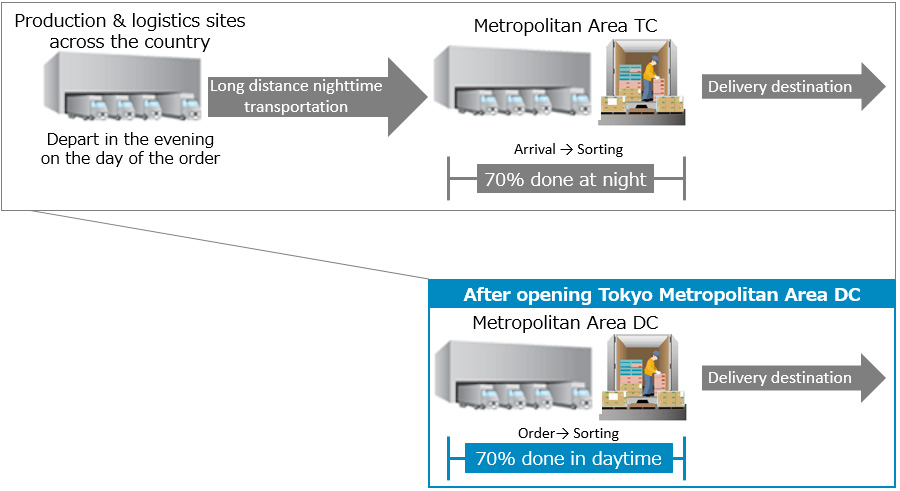
Example of changes in the work process for immediate delivery following the opening of the Tokyo Metropolitan Area DC
Promoting modal shifts to reduce driver working hours and contributing to the reduction of CO2 emissions
Proper inventory management also allows for efficient methods of transporting items for scheduled deliveries. For example, products manufactured at the Kyushu Plant and sold in the Tokyo metropolitan area are transported from the Kyushu DC (Kumamoto Prefecture) to the Tokyo Metropolitan Area DC, and from there to the delivery destination. Urgent deliveries are shipped by trunk line transportation, but if products are already kept in inventory close to their delivery destination, then shipping over long distances by truck becomes unnecessary. Such inventory can be shipped systematically and all at once, allowing for wider time margins and enabling modal shifts that convert the mode of transportation from truck to rail or ship. In advance of beginning full-scale operation, the Tokyo Metropolitan Area DC has begun receiving shipments from the Kyushu DC via ferry. By truck, it would take two drivers taking turns driving a double trailer truck three days to complete the 1,300-km journey there and back. When ferries are used, trucks are only required on the two sections from the Kyushu DC to the port of origin, and from the port of destination to the Tokyo Metropolitan Area DC. Only one driver needs to be assigned to each of these sections, and they can complete their journeys in just five hours (round trip) for a significant reduction in working hours.
From the perspectives of both responding to the 2024 problem and caring for the environment, we are promoting a modal shift from trucks to rail and ships for transportation distances of 700 km or more. Opening the Tokyo Metropolitan Area DC enables us to optimize the inventory balance at each logistics site as we aim to cut CO2 emissions by 30% in FY2025 compared to FY2022 by leveraging modal shifts.

Trucks disembarking from a domestic vessel
Developing a Goods-to-Person (GTP) system
In addition to improving transportation efficiency, the Tokyo Metropolitan Area DC will be the first of YKK AP's logistics sites to operate a Goods-to-Person (GTP) sorting system that will reduce the workload of sorting personnel. We spoke to Shiro Yokoi, head of the SCM Department's Technological Development and Planning Office, to learn more about GTP.
Unlike conventional warehouse picking operations, in which a worker walks between fixed shelves where products are stored and picks out the required items, a GTP system—also called a "shelf-transporting robot"—has a robot bring the items to the worker. Although GTP systems are already widely used in e-commerce logistics, they have not yet been very widely adopted in the field of architectural products, which involve large items such as windows and doors. However, even our product lineup includes small items such as screws, components, and parts. In fact, roughly 10% of all the items we ship consist of such small products. We therefore first started developing a GTP system to be used for the shipment of small components that are small, lightweight, and easy to pick. In doing so, we paid particular attention to sorting by subdivided directions.

A shelf-transporting robot

Storage shelves

A GTP system that can handle picking and sorting for 100 truck destinations at once
Conventional picking operations consisted of a human being receiving an order and then walking down the aisles, searching for the items in the shelves. Not only was the work physically demanding, but the speed and efficiency also varied depending on the level of experience of the workers in question, as those who were familiar with the locations of all the shelves could naturally search for items faster than others. With the introduction of shelf-transporting robots, the process was converted into one in which "the robots carry the shelves to fixed locations for each product." In addition, since the Tokyo Metropolitan Area DC covers a wide shipping area encompassing Tokyo and its seven surrounding prefectures, it was originally developed as a two-stage process, with items first being sorted by prefecture, and then by truck destination. However, our aim was to develop a system that could carry out the picking and classification according to truck destination in one single operation. To complete this system, we analyzed all historical shipment data to determine the number of destinations to which small components were shipped. In order for one worker to be able to sort roughly 300 types of small components alone, we repeated tests under a variety of conditions such as the appropriate number of shelves, the lines of flow for taking an item down from a shelf, effective layouts, and more. And so, despite the difficulties we faced from system control, we finally developed a GTP system that could classify products for 100 truck destinations at a time. It can pick between 800 and 1,200 products in one day. For a human to carry out this amount of picking while walking around takes 6 to 8 hours, but with GTP, the work can be completed within 3 to 4 hours, as one can pick and sort for 100 destinations at once while remaining in a fixed position. The system therefore achieves a remarkable reduction in on-site working hours and a lower overall labor burden.
A human worker receives an order and then walks down the aisles, searching for the items in the shelves

Robots carrying the shelves to fixed locations for each product

Developing sustainable logistics to become a shipper that is chosen by others
With its inventory management, promotion of modal shift, and adoption of a GTP system, the Tokyo Metropolitan Area DC is an advanced logistics site. However, as a shipper, there is still much more that we could do. Above all, improving working conditions for truck drivers, including tackling the 2024 problem, is an urgent issue that shipper companies must address. "As a shipper," says Mr. Migitani, "we must develop a structure that reduces the burden on drivers, such as, for example, by reviewing the way we hold inventory and selecting transportation methods according to the lead times." In addition, the labor shortage is becoming a serious issue not only for drivers but also for on-site workers. Mr. Yokoi adds: "Our aim is to promote automation with robots to create an environment where anyone can work with ease, without the need for unnecessary physical exertion." The Tokyo Metropolitan Area DC will serve as a precedent for other logistics sites to follow as we further improve the efficiency of YKK AP logistics as a whole in our aim to become a shipper chosen by others.
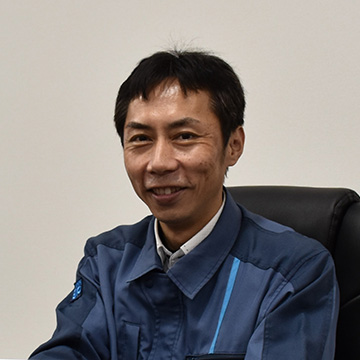
Mitsuhiro Migitani
Joined the company in 1992 and put in charge of warehousing and shipping operations at the Kyushu Distribution Center. Managed inventories and customer shipping as the head of the Kyushu Distribution Center (currently the Kyushu DC) from 2008. Transferred to the Logistics Section Planning Office in 2013, where he was in charge of factory shipping operations and worked on improving supply. In charge of improving supply at the Saitama MADO (Window) Plant's Tokyo Metropolitan Area Block since 2023.
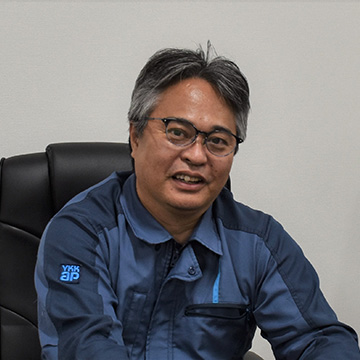
Shiro Yokoi
Joined the company in 1994 and assigned to the Fabrication Technology Center, where he worked on packaging technology until 2005. Put in charge of logistics at the Saitama MADO (Window) Plant in 2011, and then transferred to the Logistics Promotion Department in 2017. In charge of the development of the GTP system since 2022.
Share this article
- SNS Link X X Share
- SNS Link Facebook Facebook Share
- SNS Link LinkedIn LinkedIn Share
- SNS Link LINE LINE Share
- Copy Link Copy Link Copy Link Copied Link
Related stories
-

Developing sustainable logistics: our efforts as an architectural product manufacturer to solve the 2024 problem and reduce driver working hours
- Logistics
- Sustainability
- Solving Social Issues
- Story of Project
-

YKK AP and residential businesses team up for housing performance improvement renovation as a way to solve the vacant house issue
- Residential Business
- Sustainability
- Solving Social Issues
- Story of Project
-

The Evolution of the Aluminum Profile Department into the Automotive Industry’s Manufacturer of Choice
- Aluminum Profile
- Technology
- Sustainability
- Solving Social Issues

